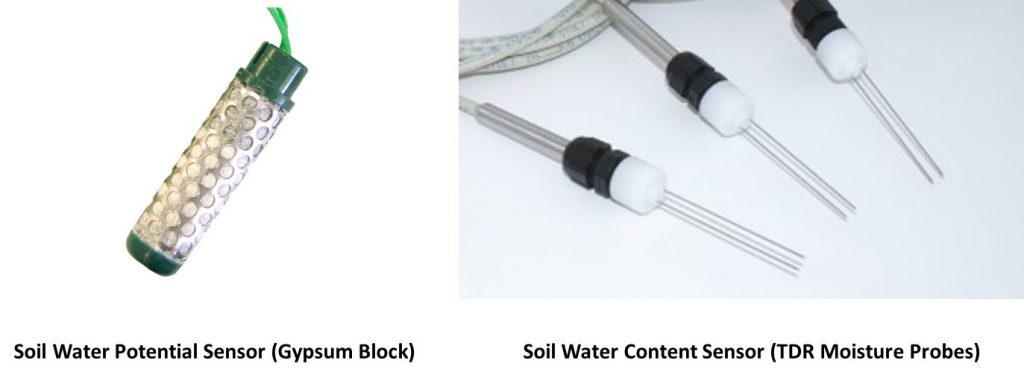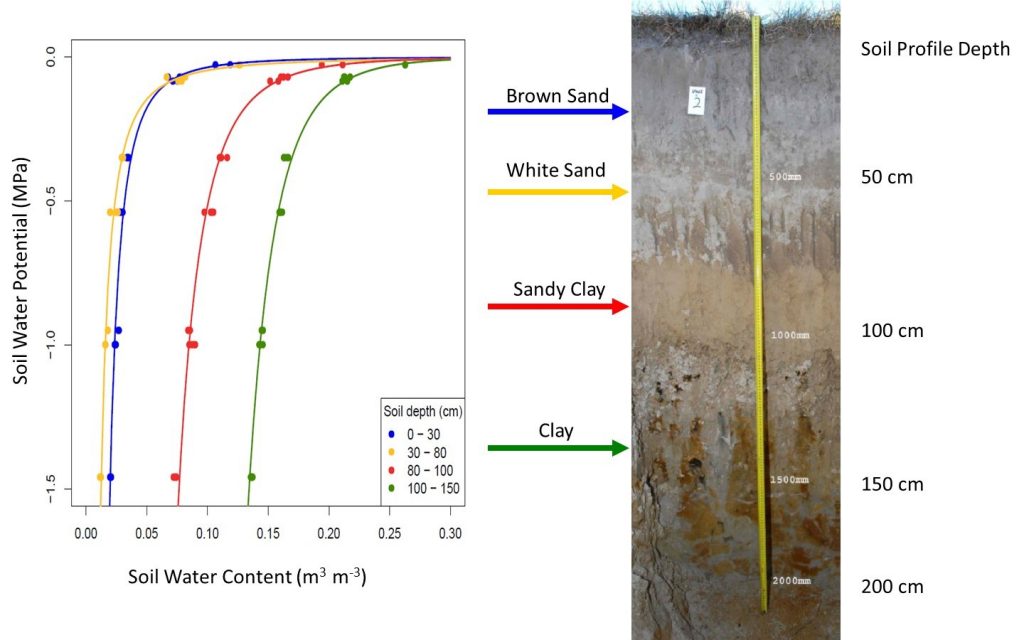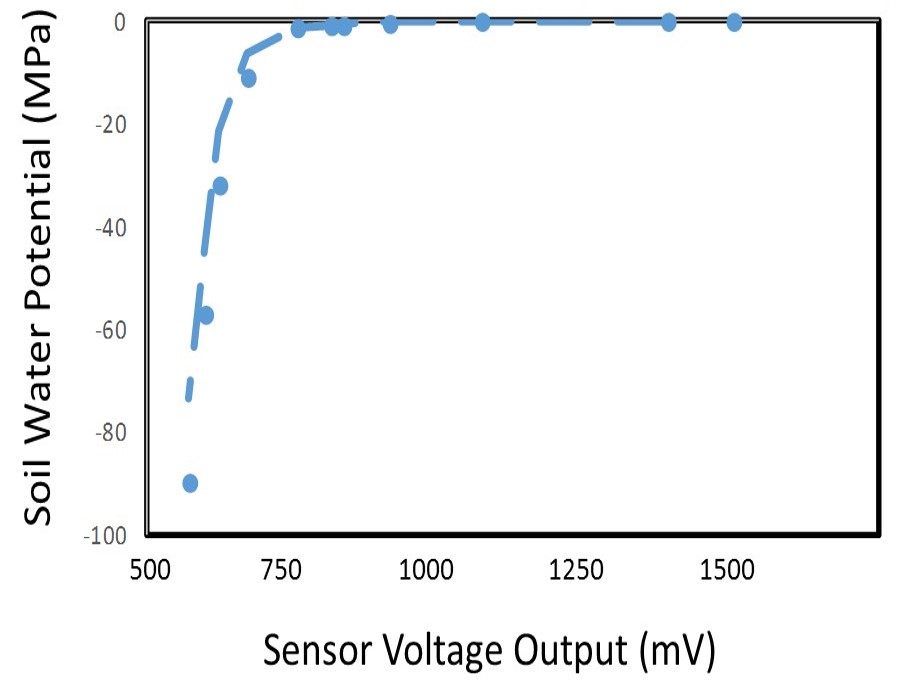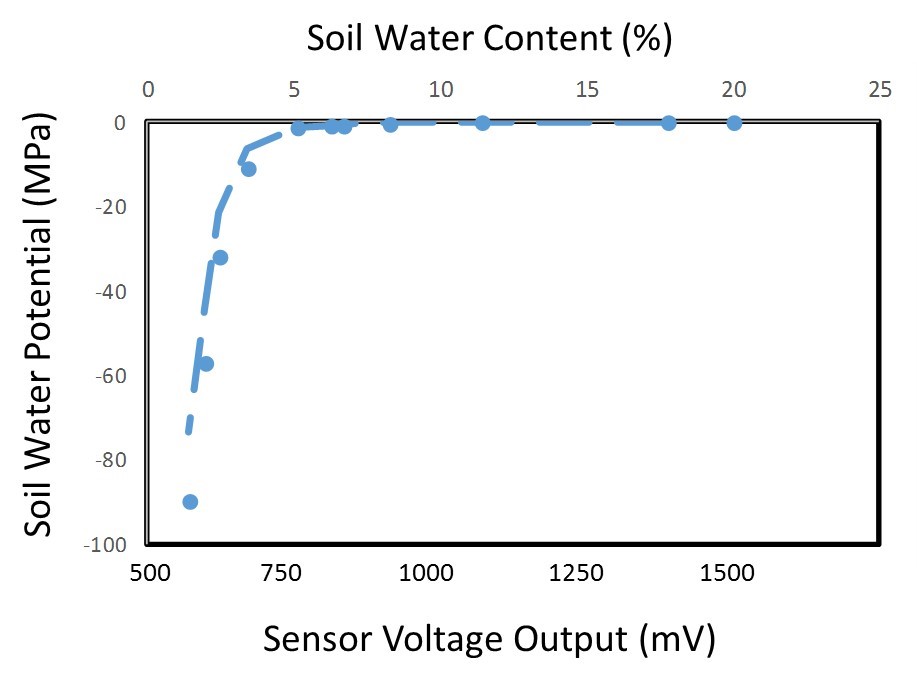how to measure soil water potential with a soil moisture sensor
 Soil water content and water potential are typically measured with two separate sensors. However, it is possible to measure both of these parameters with a single sensor. This article outlines how and the equipment you will need to achieve this.
Soil water content and water potential are typically measured with two separate sensors. However, it is possible to measure both of these parameters with a single sensor. This article outlines how and the equipment you will need to achieve this.
basic principles
Water potential and water content sensors do not measure water directly. Every single technology that is currently available measure something else and then soil water is inferred, or calibrated against, this measurement.
Most soil water sensors measure the dielectrical permittivity of soils, others measure thermal properties, or hydrogen content (neutrons), or pressure in a water column.
As soil water sensors are calibrated readings, it is possible to calibrate them against any standard. This is the basic principle behind how soil water potential can be measured with a soil water content sensor.
But to understand how to do this, first it is important to know the differences and similarities between the different types of sensors.
what is the difference between a soil water potential and soil water content sensor?
There are 3 main differences between soil water potential and content sensors:
- The sensors look different. Soil water potential sensors include gypsum blocks and tensiometers. Soil water content sensors include capacitance or time domain reflectometry (TDR) sensors. Their physical appearances are obviously different, as can be seen in Figure 1:

Figure 1. An example of a soil water potential and soil moisture sensor where their physical appearance is obviously different.
- The output from the sensors is also different. Soil water potential is the amount of energy available needed for a plant to extract water from the soil. Therefore, gypsum blocks and tensiometers output values in units associated with energy or pressure, such as centibars or kilopascals or pF.
Soil water content is how much water there is in a given amount, or volume, of soil. Capacitance and TDR sensors give an output as a percentage – typically expressed as percent volumetric soil water content.
- The third difference is their relationship to the physical properties of soils and how this affects calibration of the sensors. Physical properties of soils include their particle size and structure with the familiar broad categories of sand, silt and clay.
Soil water potential is independent of soil physical properties. It is similar to measuring temperature in soil. A temperature measurement in sand or clay will be the same and is not affected by physical properties of the soil. Similarly, a soil water potential measurement is the same whether it is measured in sand, silt or clay.
Soil water content, on the other hand, is dependent on soil physical properties. Commercially available soil water content sensors have a default percentage value output which is based on a generic, or average, calibration curve. The real output value will depend on whether your sensor is installed in sand, silt, clay or artificial substrates such as potting mix or glasshouse substrates. For accurate measurements, soil water content sensors need to be calibrated to your specific soil or substrate type – an issue which is discussed here. How to calibrate soil water content sensors is described in detail here.
what are soil water sensors measuring?
 There is not a single sensor or piece of technology available that can measure soil moisture directly. All sensors measure something else and then water content or potential is then inferred from this.
There is not a single sensor or piece of technology available that can measure soil moisture directly. All sensors measure something else and then water content or potential is then inferred from this.
For example, capacitance and TDR soil moisture content sensors measure the dielectric permittivity of soil – or how much electrical charge or storage there is in the soil. With higher water content, there is more electrical storage and, therefore, a higher dielectric permittivity. A calibration curve can then be found that relates the dielectric permittivity of the soil to its real volumetric water content.
Soil water potential sensors come closer to measuring the actual energy available in the soil. For example, a tensiometer measures how much tension, or energy, is exerted on a water column that is in contact with the soil. The drier the soil, the higher the tension or the higher the amount of energy that is exerted on the water column. This tension is then measured by a pressure gauge or pressure transducer.
but if a soil water content sensor measures dielectric permittivity, how can it then actually measure soil water potential?
When soil water potential or content sensors are connected to a data logger, they need to have an electrical output. That is, they have a voltage or current (milliamp) output that can be detected by the data logger or recorder.
Our soil moisture sensor has a voltage output between 500 mV and 1500 mV; whereas a pressure transducer attached to a tensiometer may have a voltage output between 0 mV and 1000 mV. So it’s then simple algebra to find one from the other.
You will still need to do some work to know what the relationship is between soil water potential and water content if you want your sensor to read one or the other or both simultaneously. You will need to create a moisture release curve, also known as a soil moisture characteristic curve.
soil moisture characteristic curves (SMCC)
An SMCC is the mathematical relationship between soil water potential and soil water content. This relationship will be different depending on your soil physical characteristics.
For example, Figure 2 is a soil profile with related soil moisture release curves for four different soil physical types. At the site, at the Hawkesbury campus of Western Sydney University, the four different types of soil were: brown sand, white sand, sandy clay and clay. The graph beside the image shows the SMCC’s for the four different soil types. As can be seen, the curves do differ and this can have important outcomes for the interpretation of your data.

Figure 2. A series of four soil moisture release curves from a single soil profile in Western Sydney, Australia.
a video explainer on soil moisture characteristic curves
how to convert your soil moisture sensor into a soil water potential sensor
You will need to measure your soil with varying levels of soil water potential (i.e. from very wet to very dry soil) with simultaneous measurements of your soil water content sensor’s voltage, or current, output. You will then find a curve, similar the curve in Figure 3, and fit an appropriate mathematical equation. You can then use this equation in your data logger for subsequent soil water potential measurements.

Figure 3. An example relationship between a soil moisture content's voltage (mV) output and soil water potential.
how to simultaneously measure soil water potential and content with a single sensor
Follow the same procedure as just describe, except you will also need to measure the volumetric water content of your soil. A detailed description on how to calibrate your soil water content sensor to measure true volumetric water content can be found here. The curve in Figure 4 is the same as the curve in Figure 3, but now includes an axis for volumetric water content.

Figure 4. Soil water potential, water content, a mV output from a moisture sensor are all related to each other.
The equation for the curve that relates voltage to soil water potential to soil water content, for this particular soil, is:
mV = 50 * Soil Volumetric Water Content + 500
mV = 855.03 * Soil Water Potential ^ -0.094
Soil Volumetric Water Content = 5.835 * Soil Water Potential ^ -0.248
 required equipment
required equipment
Edaphic Scientific supplies the complete range of equipment you will need to simultaneously measure soil water content and soil water potential.
Our range of soil water content sensors are either point sensors, for glasshouses or shallow soils, or profile probes for deeper soils.
Soil moisture release curves can be generated with our laboratory based water potential meters such as the WP4-C or HYPROP.
Edaphic Scientific also supplies a complete range of soil water potential sensors including the MPS-6 or tensiometers.
The sensors, and calibrated curves, can be connected to the ES-SYS range of data logging systems with internet access to data.
Need further assistance? Contact one of our soil scientists.
